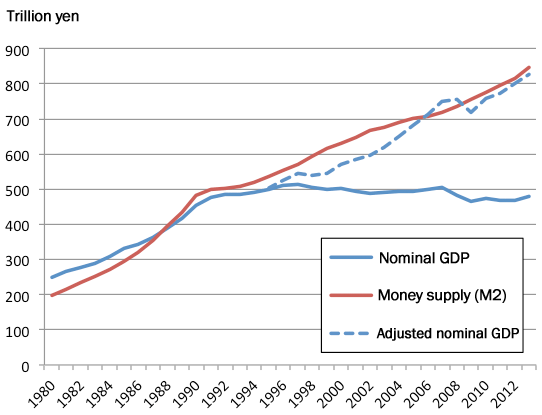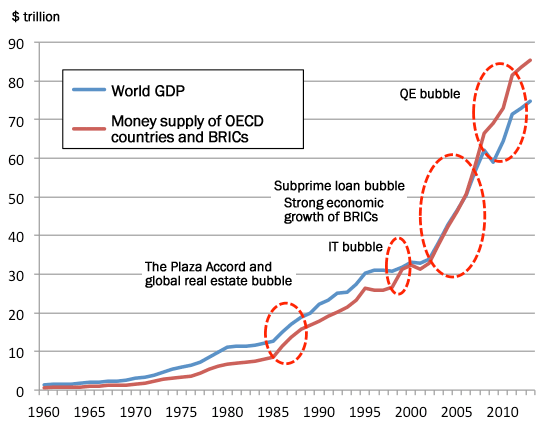Japan's nominal GDP and money supply: A wide divergence
The Japanese economy has been on a recovery track since mid-2012, due in part to Abenomics. Although the economy has slowed recently, it is expected to turn upward again, thanks to additional fiscal and economic measures, high stock prices coupled with the weak yen, and the low price of oil.
A policy that particularly merits attention is the quantitative easing by the Bank of Japan with its goal of purchasing 80 trillion yen of Japanese government bonds annually as it strives to achieve a 2% price stability target. Long-term interest rates are at its lowest level ever, between 0.2% and 0.3%. Moreover, because of trends such as the growing gap between Japan and U.S. interest rates, Japan is seeing high stock prices coupled with the weak yen. These can be expected to further improve business/consumer confidence and inflation expectations from both corporations and households.
A look at the Japanese nominal gross domestic product (GDP) and the money supply (M2 base) in recent years shows that whereas the money supply continued to increase from the mid-1990s until recently, nominal GDP has been flat. Such a long-term deviation between nominal GDP and the money supply seems highly irregular as economic growth typically indicates additional demand for financing. If the money supply increases sharply, financial assets and real estate prices rise while exchange rates fluctuate, and such trends are expected to have an impact on economic growth as well. In the major economies of Europe and North America, nominal GDP and money supply grow together.
So why are nominal GDP and the money supply diverging so conspicuously from each other solely in Japan? One reason has to do with where the money is diverted to once the supply has increased. The most important part of the increase in the money supply since 1995 has gone toward purchasing the expanded amount of Japanese government bonds. In other words, the money went into public works, which have a lower economic multiplier effect than private investment.
The biggest reason of all has to do with business behavior. In the last 20 years since the collapse of the real estate bubble, businesses increasingly have shown a tendency to contract and households have not been able to increase their consumption. Given this background, domestic demand has been sluggish and deflation has kept nominal GDP in check. The impact of deflation has been particularly significant. Assuming that Japan's rate of price increases (GDP deflator) had been the same as that of the United States, that, combined with Japan's nominal GDP, would lead to a big increase consistent with growth in the money supply (Fig. 1).

Money drives the world economy
On the other hand, a look at the world economy shows that the weight of finance has grown greater year by year. Figure 2 shows the world nominal GDP and the money supply (M2 base) of major OECD (Organisation for Economic Co-operation and Development) countries and BRICS over time. The amount of money in circulation has increased faster than nominal economic growth in recent years. Also, periods in which the money supply grows sharply overlap those periods where nominal GDP also grows sharply. These periods occurred in the latter half of the 1980s (the era of the Plaza Accord and global real estate bubble), the latter half of the 1990s (IT bubble), and the 2000s (the subprime loan bubble in the United States and the strong economic growth of newly emerging economies such as the BRICS).

Such overlaps of good economic growth and a big increase in the money supply can be seen even now. To give one example, the United States overcame its Great Recession after the collapse of Lehman Brothers by monetary easing policies, most notably three rounds of quantitative easing. The economy of the Eurozone, on the other hand, continues to struggle. Some of the reasons include the region prioritizing restoring fiscal soundness after the occurrence of European debt crises and, without quantitative easing, a lack of increase in the money supply.
Of course, excessive monetary easing and increases in the money supply create the risk of a financial bubble, which could collapse and have serious harmful effects on the economy. A financial bubble is obviously not a good thing, but allowing the economy and money supply to stay disconnected is not positive either. In short, it is vital to achieve some balance wherein the economy and money supply have a certain correlation with each other. The desired outcome is that the two will influence each other and create solid economic growth.
From this perspective, it cannot be said that the current situation in Japan is desirable, since the nominal GDP remains flat in spite of an increased money supply. So even if we accept that an increased money supply will not lead automatically to economic growth, we should work to restore the correlation between the economy and money supply in Japan. The biggest prerequisite is to achieve a mild level of inflation to increase nominal economic growth. If Japan could achieve nominal growth consistent with the increase in the money supply, it would boost the possibility of supporting greater economic growth because, for example, the additional money would stimulate financial transactions.
Of course, it is difficult to get mild inflation firmly established, as the Japanese economy has shown. Moreover, paving the way for economic growth and mild inflation with monetary policy alone when there is such a weak correlation between the economy and the money supply is not a simple matter. To do this, it will be absolutely essential for the public and private sectors to work together to restore a balanced correlation between the economy and the money supply through such means as further easing of financial and real estate regulations. Among other things, this will mean additional encouragement of a shift from saving to investing—a goal that has been talked about for many years but never achieved—and turning the financial industry, which is large but derives only small profit margins, into a more lucrative growth industry.

